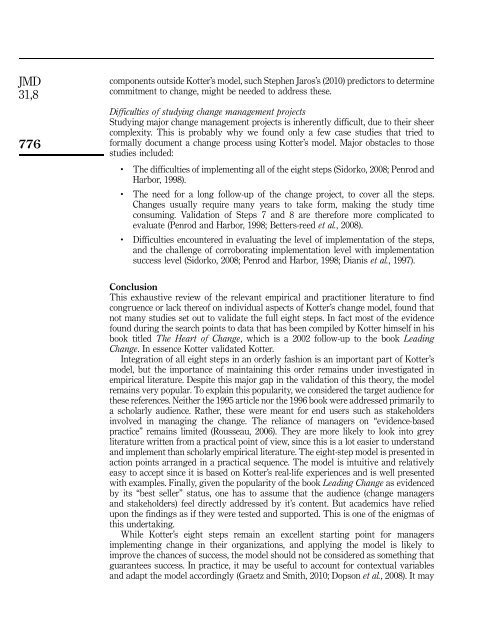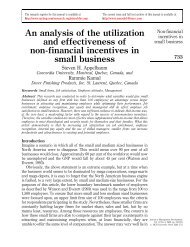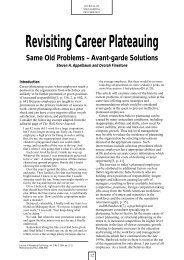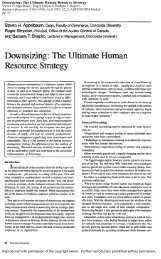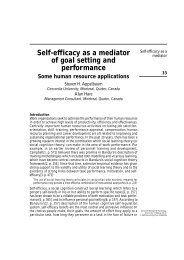Back to the future: revisiting Kotter's - Dr. Steven H. Appelbaum ...
Back to the future: revisiting Kotter's - Dr. Steven H. Appelbaum ...
Back to the future: revisiting Kotter's - Dr. Steven H. Appelbaum ...
Create successful ePaper yourself
Turn your PDF publications into a flip-book with our unique Google optimized e-Paper software.
JMD<br />
31,8<br />
776<br />
components outside Kotter’s model, such Stephen Jaros’s (2010) predic<strong>to</strong>rs <strong>to</strong> determine<br />
commitment <strong>to</strong> change, might be needed <strong>to</strong> address <strong>the</strong>se.<br />
Difficulties of studying change management projects<br />
Studying major change management projects is inherently difficult, due <strong>to</strong> <strong>the</strong>ir sheer<br />
complexity. This is probably why we found only a few case studies that tried <strong>to</strong><br />
formally document a change process using Kotter’s model. Major obstacles <strong>to</strong> those<br />
studies included:<br />
.<br />
The difficulties of implementing all of <strong>the</strong> eight steps (Sidorko, 2008; Penrod and<br />
Harbor, 1998).<br />
.<br />
The need for a long follow-up of <strong>the</strong> change project, <strong>to</strong> cover all <strong>the</strong> steps.<br />
Changes usually require many years <strong>to</strong> take form, making <strong>the</strong> study time<br />
consuming. Validation of Steps 7 and 8 are <strong>the</strong>refore more complicated <strong>to</strong><br />
evaluate (Penrod and Harbor, 1998; Betters-reed et al., 2008).<br />
.<br />
Difficulties encountered in evaluating <strong>the</strong> level of implementation of <strong>the</strong> steps,<br />
and <strong>the</strong> challenge of corroborating implementation level with implementation<br />
success level (Sidorko, 2008; Penrod and Harbor, 1998; Dianis et al., 1997).<br />
Conclusion<br />
This exhaustive review of <strong>the</strong> relevant empirical and practitioner literature <strong>to</strong> find<br />
congruence or lack <strong>the</strong>reof on individual aspects of Kotter’s change model, found that<br />
not many studies set out <strong>to</strong> validate <strong>the</strong> full eight steps. In fact most of <strong>the</strong> evidence<br />
found during <strong>the</strong> search points <strong>to</strong> data that has been compiled by Kotter himself in his<br />
book titled The Heart of Change, which is a 2002 follow-up <strong>to</strong> <strong>the</strong> book Leading<br />
Change. In essence Kotter validated Kotter.<br />
Integration of all eight steps in an orderly fashion is an important part of Kotter’s<br />
model, but <strong>the</strong> importance of maintaining this order remains under investigated in<br />
empirical literature. Despite this major gap in <strong>the</strong> validation of this <strong>the</strong>ory, <strong>the</strong> model<br />
remains very popular. To explain this popularity, we considered <strong>the</strong> target audience for<br />
<strong>the</strong>se references. Nei<strong>the</strong>r <strong>the</strong> 1995 article nor <strong>the</strong> 1996 book were addressed primarily <strong>to</strong><br />
a scholarly audience. Ra<strong>the</strong>r, <strong>the</strong>se were meant for end users such as stakeholders<br />
involved in managing <strong>the</strong> change. The reliance of managers on “evidence-based<br />
practice” remains limited (Rousseau, 2006). They are more likely <strong>to</strong> look in<strong>to</strong> grey<br />
literature written from a practical point of view, since this is a lot easier <strong>to</strong> understand<br />
and implement than scholarly empirical literature. The eight-step model is presented in<br />
action points arranged in a practical sequence. The model is intuitive and relatively<br />
easy <strong>to</strong> accept since it is based on Kotter’s real-life experiences and is well presented<br />
with examples. Finally, given <strong>the</strong> popularity of <strong>the</strong> book Leading Change as evidenced<br />
by its “best seller” status, one has <strong>to</strong> assume that <strong>the</strong> audience (change managers<br />
and stakeholders) feel directly addressed by it’s content. But academics have relied<br />
upon <strong>the</strong> findings as if <strong>the</strong>y were tested and supported. This is one of <strong>the</strong> enigmas of<br />
this undertaking.<br />
While Kotter’s eight steps remain an excellent starting point for managers<br />
implementing change in <strong>the</strong>ir organizations, and applying <strong>the</strong> model is likely <strong>to</strong><br />
improve <strong>the</strong> chances of success, <strong>the</strong> model should not be considered as something that<br />
guarantees success. In practice, it may be useful <strong>to</strong> account for contextual variables<br />
and adapt <strong>the</strong> model accordingly (Graetz and Smith, 2010; Dopson et al., 2008). It may


